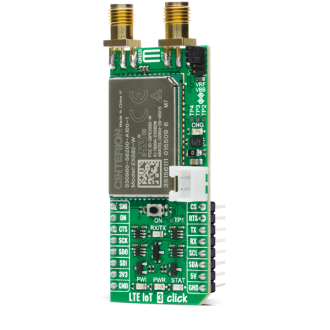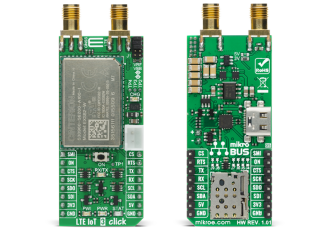
We strongly encourage users to use Package manager for sharing their code on Libstock website, because it boosts your efficiency and leaves the end user with no room for error. [more info]

Rating:
Author: MIKROE
Last Updated: 2020-08-17
Package Version: 1.0.0.0
mikroSDK Library: 1.0.0.0
Category: GSM/LTE
Downloaded: 3149 times
Not followed.
License: MIT license
LTE IoT 3 Click is a compact add-on board that contains a Low Power Wide Area (LPWA) Wireless IoT module that allows connections to the LTE, NB-IoT, and 2G networks. This board features the EXS82-W, LTE-IoT Wireless Module from Thales that offers a rich set of Internet protocols and industry-standard interfaces such as UART, USB, etc.
Do you want to subscribe in order to receive notifications regarding "LTE IoT 3 Click" changes.
Do you want to unsubscribe in order to stop receiving notifications regarding "LTE IoT 3 Click" changes.
Do you want to report abuse regarding "LTE IoT 3 Click".


Library Description
Library provides function for controlling device pins, and function for sendint AT commands over UART communication.
Key functions:
void lteiot3_send_cmd ( uint8_t *cmd_buf ) - Function for sending commands to device.void lteiot3_set_pin_on ( uint8_t pin_state - Function for setting on pin state.Examples description
The application is composed of three sections :
void application_task ( )
{
lteiot3_send_cmd( &AT_CGATT[0] );
Delay_ms( 5000 );
log_buffer();
lteiot3_send_cmd( &AT_CEREG[0] );
Delay_ms( 5000 );
log_buffer();
lteiot3_send_cmd( &AT_CSQ[0] );
Delay_ms( 5000 );
log_buffer();
}
Other mikroE Libraries used in the example:
Additional notes and informations
Depending on the development board you are using, you may need USB UART click, USB UART 2 click or RS232 click to connect to your PC, for development systems with no UART to USB interface available on the board. The terminal available in all MikroElektronika compilers, or any other terminal application of your choice, can be used to read the message.